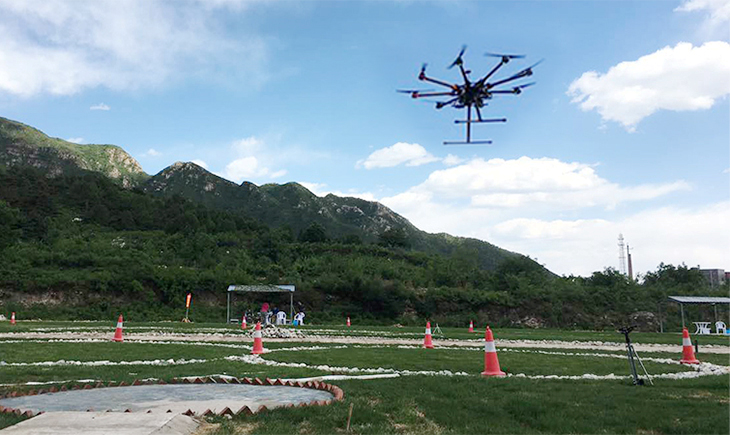By Shi Zhipeng
“Go forward and turn direction. Lightly press on the left rudder!”
“Make the right angle and direction. Pay attention to the height of your drone.”
At the LTFY drone training school in Changping district of Beijing, Wu Haining, in a black sweatshirt, was instructing trainees to control their drones.
After the drones landed smoothly, they walked to a flight simulation training device and started analyzing the flight paths.
Wu, 30, is a drone pilot. He calls his line of work “flying aircraft on the ground.”
In 2019, unmanned aerial vehicle (UAV) pilot was listed as a new profession in China’s occupational classification. In recent years, drone pilots have been in strong demand due to the rapid development and wide application of drone technologies. It is estimated that China needs nearly 1 million drone pilots by 2025.
In 2019, the human resource and social security bureau of Beijing’s Yanqing district started free drone training for young people. Wu, an enthusiast of remote-controlled model cars since childhood, registered for the training.
He never expected at that time that the training would bring him into a whole new life.
“Piloting drones is a cool thing,” said Wu. He was fascinated by the “flying machine” just after a few classes. He worked hard to understand the theories, applications and maintenance of drones, and kept improving his skills of piloting.
After the training session, he became one of the first licensed drone pilots in Yanqing district.
Wu shared with People’s Daily a story about rescuing two backpackers lost in the wild mountains of Changping district with drones.
According to Wu, it was too slow to search the large mountainous area by manpower alone, so relevant departments in Changping district came to his team and asked them to assist ground rescuers with thermal imaging drones.
“We located the lost backpackers with drones and guided the rescuers to go down the mountain,” Wu recalled. This experience made Wu realize that he must improve his drone piloting skills to bring out the full potential of the machines.
Wu was always on business trips these days due to the increasing demand for pilot training as more application scenarios of drones were developed.
Today, drones have been widely used in multiple areas including emergency rescue, agriculture and forestry protection, meteorological observation, electric power inspection, aerial mapping and filming.
At the drone training school in Changping, a man surnamed Yao was operating a drone controller.
Yao, in his fifties, came from northwest China’s Ningxia Hui autonomous region and works in the communication industry. During his 12-day stay at the training school, he had acquired the basic operating skills of drones, but there was still room for improvement from what was shown on the flight simulation training device.
“Drones equipped with communication devices can rapidly establish temporary communication networks. They are very important in emergency response,” Yao told People’s Daily.
Wang Shiyu from the ecology and environment bureau of the Xinjiang Production and Construction Corps also joined the same training session.
“My routine work is to monitor pollution discharge in industrial parks, inspect discharge outfalls, patrol water sources and nature reserves,” Wang said, adding that ecological monitoring is now multi-dimensional thanks to drones, which has significantly improved his work efficiency and quality.
“Safety” and “standard operation” are frequently mentioned by coaches and trainees at the school. These are vital for the healthy and orderly development of a new profession.
The development of civil drones once led to disorderly conduct. One of the biggest headaches was unregistered and unapproved flights.
Recently, China unveiled a set of provisional regulations on UAV management. As the first specialized administrative regulation on UAVs in China, it strengthens the management of drones and pilots, sets airspace that is open to drones, and normalizes flight activities.
The regulation is conducive to the sustainable and healthy development of the industry, Wu said.
He told People’s Daily that a drone license only helps a pilot get a foot in the door, and what a drone can do depends on its performance and the mission assigned.
“We are more than drone pilots. We must dig deep into specific areas. For instance, we should know photography if we join a mission of aerial filming; we should have agricultural knowledge if we want to do better in plant protection missions,” Wu said.
As drones are widely used in more and more industries, the demand for pilots is rising. The profession will be subdivided into different fields, Wu told People’s Daily, adding that more and more people will realize their flying dreams through drones.
Sunday, June 22, 2025
China sees rising demand for drone pilots
Newsletter
Lorem ipsum dolor sit amet, consectetuer adipiscing elit. Aenean commodo ligula eget dolor.
SUBSCRIBE
Site Links
About Us
We bring you the best Premium WordPress Themes that perfect for news, magazine, personal blog, etc. Check our landing page for details.












